Udvada and Navsari towns in Gujarat were once home to a thriving Parsi community that is now rallying to increase its numbers, archive its history, safeguard its memories, and restore its records.
Article by Shubhangi Misra | The PRINT

The once famous Great Majestic Hotel, surrounded by coconut trees, lies abandoned | Photo: Manisha Mondal/ThePrint
Navsari/Udvada: If the Great Majestic Hotel by Udvada beach in Gujarat could talk, it would tell stories of wealthy Parsis partying, of corridors bathed under the glow of chandeliers and champagne flowing from fluted glasses. Plymouths and Bentleys would line up on its porch bearing Parsi families visiting the pilgrimage town by the Arabian Sea. Today, almost three decades later, most of the Parsis have vanished. And cows, cats, bats, lizards, and snakes roam the Great Majestic, which bolted its doors in the 1990s.
“I have nobody to talk to all day. Most Parsi log have gone away to Mumbai. Nobody wants to stay here,” says 64-year-old Dilip Bhai Patel, a sandalwood shopkeeper. “It wasn’t always like this. It makes me sad,” he adds, as six pairs of keys—all belonging to vacant Parsi houses he has been hired to maintain—jingle in his pockets.
The degradation and disintegration of the Great Majestic is the story of Udvada, home to the Atash Bahram fire temple where the holy fire has been burning continuously for over a thousand years. But the community doesn’t want its roots to become ghost towns. Upper middle-class Parsis are returning to renovate their homes. Already a few restored houses are operating as Air BnBs. Seventy-five kilometres away in Navsari, the first home of Parsis in India, the Jeejeebhoys and Tatas have restored their ancestral properties, heritage walks are being organised, and the houses of prominent Parsis are being converted into museums.
Udvada and Navsari are museums of memory for a once thriving Parsi community that is now rallying to increase its numbers, archive its history, safeguard its memories, and restore its records.
Though Udvada is not seeing a churn like Navsari, Shernaz Cama, founder of the Parsi Zoroastrian organisation Parzor, sees the potential of both places if they are developed along the lines of heritage European towns. “The potential of heritage tourism is massive, and inspiration can be drawn from Rajasthan and Gujarat,” she says.
But the best of intentions is marred by the community’s exclusionary practices, especially among the conservative members. Efforts to revive Navsari and Udvada are stymied by the limited number of Parsis, paucity of funds, encroachments, pushback from old residents who don’t want to be on a tourist map, their refusal to open their doors to non-Parsis, and internal politicking.
Many Parsis across India want Udvada to be recognised as a Unesco World Heritage site, but for that to happen, it has to give access to everyone without discrimination on the basis of race, ethnicity, or gender.
“The fact that only Parsis can enter the fire temple, or some dharamshalas are reserved for Parsis… UNESCO won’t stand for it,” Cama says.
In 2018, minority affairs minister Smriti Zubin Irani had adopted Udvada and promised to turn it into a model village. A corpus of Rs 8.4 crore was granted with plans for a primary health centre, CCTV cameras, and wifi access for everyone.
In July this year, a petition on Change.org urged Irani and Prime Minister Narendra Modi to declare the area around Iranshah Atash Behram as ’enclosed’ to protect the heritage of the town. It was signed by more than 5,000 people. But the tone reflected the sentiment among the signatories who prefer Udvada to remain a secluded place instead of a heritage town where tourist footfall boosts the economy.
“Of late, the peaceful, spiritual atmosphere is marred by influx of tourists, aimless and noisy pedestrians, unauthorised street vendors, noisy gatherings, loud speakers breaking the quiet atmosphere, during elections, or wedding processions…” read the petition.)
For many Parsis, the silence, the abandoned heritage homes and the overarching miasma of decay are more preferable than commercialisation. It’s akin to the traditionalists wanting to preserve purity of bloodlines at the cost of extinction. ‘We like it this way’ is a common refrain among the remaining residents of Udvada.

An abandoned Parsi house in Udvada has been claimed by creepers over the years | Photo: Manisha Mondal/ThePrint
“We’d have nowhere to go if we open up these spaces for members of other communities,” 72-year-old Aspi Barjor Chhapgar, who owns 18 properties in Udvada, says. “We are a dying race, we need such spaces to maintain the purity of our pilgrimage town.”
A ghost town with old mansions
In this graveyard of mansions, a few houses flicker with life. The homes of the last senior citizens, the sentinels of Udvada’s heritage, and the prodigals returning to pick up the torch. One of them is Neeraj Bhatia, a Mumbai-based marketer.
“Covid gave me time to come to my house and repair it,” says Bhatia, who has restored his mother’s 100-year-old home. “A lot of people in our community, especially the salaried class from Mumbai, have earned enough money to put into their houses back in Udvada,” he adds.
There are some elders in the community who want to commit their life savings to the benefit of their pilgrimage town. This is their way of worship, the holiest way to give back to their community. Chhapgar bought 18 houses with the intention of turning them into free-of-cost homestays—but only for Parsis.
“There are many senior citizens in my community who want to visit Udvada and stay there but aren’t able to, due to paucity of funds. At the same time, many old houses are up for sale by Parsis who need money, so I buy their houses at a generous price,” said Chhapgar, a former marine engineer.
But he has not been able to revive a single house because Udvada’s gram panchayat hasn’t given him clearance yet.
For now, Udvada is still filled with carcasses of centuries-old mansions—their walls without paint, wooden beams infested with termites, and windows stained with dirt. Even on Parsi New year, its streets were silent.

In Udvada, once the centre of celebrations, now remains silent e event on Parsi New Year | Photo: Manisha Mondal/ThePrint
The town doesn’t have more than 50 permanent residents, most solitary senior citizens, who live in houses built around the Atash Behram. But maintaining them is expensive, and can cost up to Rs 1-2 lakh a year.
“The Parsis are an asset rich, cash poor community,” Cama explains.
Khushroo Deboo, a farmer, has converted his 125-year-old house in Navsari into a heritage homestay, which is popular among Parsis even though it’s not listed anywhere. Everyone is welcome, including non-Parsis.
“An architect told me there’s nothing I can do about it other than repair. These are cement less walls,” he says. His is the only Parsi heritage homestay in Navsari.
As a sister town of Surat, Navsari is more commercial than Udvada. Some of its properties have been restored, but many have fallen victim to encroachments. Parsis migrated from Gujarat in large numbers after the alcohol prohibition came into effect in the 1960s, according to Cama. “Most rural Parsis used to have toddy shops, where they also sold Indian made foreign liquor. When toddy was banned, no compensation was given. The saline soil of South Gujarat does not grow very good crops, and toddy was their safety net,” Cama says.
Socialist policies in the late 1950s and early 1960s like the nationalisation of banks and transport, the Land to the Tiller Act (turning land cultivators into owners), and the Land Ceiling Act, where the government acquired land from big landlords, also hurt Parsis who were part of India’s ruling elite.
“Land ceiling really hurt the Parsis, especially because land wasn’t taken by the government from Hindu Undivided Family. So, many chose to migrate out of India,” says Cama.
And they left behind their beautiful homes full of memories and memorabilia. If they’ve not been encroached, they’ve been abandoned.
“We are unable to trace the owners of some houses. Their families seem to have vanished. Or properties are disputed, and some people have encroached into them,” says Kersi Deboo, vice-chairman, National Commission for Minorities.
Patel recalls the time when Udvada was run by elite Parsis. “They had such a huge influence here. They would always stay a little aloof; never mingled with other communities,” he says, adding that those who remain are old and dependent on their household staff.
Finding Dadabhai Naraoji
In Navsari, the revival of the First Dastoor Meherjirana library and the rescue of treasured documents have given wind to the Gaikwadi town’s sails. Talk of restoration is gathering momentum in the town of Parsi luminaries such as Sir Jamsetji Jeejeebhoy, JRD Tata, and former British Member of Parliament and Congress president Dadabhai Naoroji.
The ancestral properties of Jeejeebhoy and Tata have been painted, revived and turned into small museums visited by students and heritage walkers. On display are Jeejeebhoy’s Baronet medallion, utensils used by JRD Tata, and letters written by them.
Unfortunately, Naoroji’s one-storeyed childhood home is in a decrepit state, slowly decaying. Only its teak wood carved facade has survived the test of time. From its huge windows, the crumbling wood beams and shattered glasses are visible. It’s a marked difference from his London house that has a commemorative blue plaque, which seeks to preserve and celebrate heritage properties of notable figures in history. For a time even the older residents didn’t know which Navsari house the ‘Grand Old Man of India’ was born in.
Historian Dinyar Patel, while researching for his book Naoroji: Pioneer of Indian Nationalism traced his home, says Cama. Patel plumbed the depths of archives and records, and realised that the house had been sold to a third party. The house has now been acquired by the National Commission for Minorities vice-chairman Kersi and his brother Dara Deboo, who have set up a trust fund to convert it into a museum.
“Only the structure remains. Nothing belonging to Naraoji or any other possessions can be found there. But the house has sentimental value,” says Kersi.
The Parzor Foundation presented the government of India with a detailed project report in 2018 to renovate the house, but it hasn’t been cleared yet. “It is a historic monument. We have unearthed accounts that prove that Gandhi addressed a gathering in front of this house. It needs to be revived,” Cama says.
About a hundred years ago, every third person in Navsari was a Parsi, and the community built important foundational institutes here. “Schools, hospitals, libraries… so many public institutions were built by Parsis. We also started modern education in Navsari,” says Kersi, adding that the first schools were established in 1848.
The Tatas, too, set up schools here. According to Deboo, four colleges were built by a Parsi trust. “We have a lot of private hospitals now, but in 1911, Parsis built the Daboo hospital here, as well as DN Mehta Parsi hospital in the 1950s.” All schools and hospitals are functional today.
Revival dream in absence of money
Ruzbeh Umrigar is tapping into his hometown’s rich history by holding walking tours with the Indian National Trust for Art and Cultural Heritage (INTACH). He covers the First Dastoor Meherji Rana library, the oldest Parsi priest school in India, the Srimant Sarkar Sayajirao Gaekwad Building, residences of Jeejeebhoy and JRD Tata, and Atash Behram. The walk usually ends at Kolaji Falooda and Ice Cream, a Parsi-run enterprise.
“The heritage walk is not just about the Parsi community,” Umrigar insists. “Other communities are also actively involved, and the tour includes the Gaekwad building, which served as the district court until recently,” he said, adding the tour, one of the many organised by INTACH in the country, is free of cost and students from places like Mumbai have also joined them on occasions.
“We don’t learn local history in schools. So the idea was to educate Navsari’s children so they could connect with their soil and learn more about their roots,” he said. The tour, whose route was proposed by the Parzor Foundation and INTACH, is funded by the cultural division of Navsari’s SB Garda College, according to Umrigar.
The Parzor foundation has an ambitious plan to build a corridor in South Gujarat. “The plan is to map out the route to Dandi beach, 35 kilometres from Navsari. We want to build an interactive museum tracing the march, which won’t be too expensive and can be done within Rs 5-7 crore,” Cama said. “We need the government of India’s support, along with capable researchers and scholars to map it out properly.”
Cama is keen to tap into the tourism potential of both Navsari and Udvada. It’s been done before—in Matheran, Bhuj, and even Mumbai.
Jehan Pestonji Bhujwala, a Mumbai-based entrepreneur renovated his grand 15-room ancestral property in Bhuj and opened it as a bed and breakfast in 2015. Called ‘The Bhuj House’, it is now a homestay for people in search of ‘Parsi experience’.
“The house had been empty since 1999, and sustained damage in the 2001 earthquake. An old, restored property needs people to stay there to maintain it,” Bhujwala says. There’s Parsi food on the menu like dhanshak, a lentil mutton dal, and also a lot of egg dishes. Similar Parsi guest houses operate in Matheran and in the Andaman and Nicobar Islands. Cama says there are heritage properties in the Nilgiri Hills, which she wishes to revive.
But such ventures are yet to reach Udvada or Navsari. “There’s simply no money to revive all those properties,” argues Cama.
And then there is pushback from old residents who do not want tourists trundling into their sanctuary, taking selfies and demanding cafes, pubs, and bistros.
Mahrukh Rabadi (68), who lives alone in her 150-year-old house in Udvada, cannot imagine any other way of life.
“I like it that way. I have never been anywhere else. What’s the point of going away from home?” she says with a smile, as her attention goes back to short clips playing on her phone. “My father died in 2008. I have been living here alone since.”
A brown stray dog, probably seeking refuge from the sun, often comes to nap at the verandah while sitting on the typical swing found in Gujarati homes. She welcomes the company. “Yes, it does get lonely at times,” she says, looking up from her phone.
Behind her, the television crackles with the voice of yesteryear Bollywood singer Kishore Kumar. “Hum dono, do premi…” he croons from the television, an old model with a curved screen. And Rabadi hums along to the song that celebrates a defiant love.
This ground report is the fourth in a series called Parsipolis. Read all the articles here.
